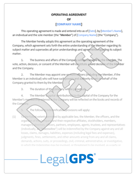How to Collect Sales Tax for Online Sales: A Step-by-Step Guide
When running an online business, one of the most confusing aspects can be navigating the world of sales tax. With each state having its own rules,...
9 min read
LegalGPS : Oct. 15, 2024
Running an e-commerce business might seem straightforward—until you hit the legal stuff. Terms & Conditions (T&Cs) can feel like one of those necessary evils, but they’re crucial for protecting your business and setting clear expectations with customers.
Don’t worry, though—this isn’t as complicated as it sounds. Let’s break down what T&Cs are, why you need them, and how you can easily create your own to keep things smooth and legally sound.


Legal GPS Pro
Protect your business with our complete legal subscription service, designed by top startup attorneys.
At their core, e-commerce terms & conditions are legal agreements that outline the relationship between your business and its customers. They set the ground rules for how your website can be used, what customers can expect, and how disputes should be handled. Having comprehensive T&Cs helps to safeguard your business while clearly informing customers about their rights and obligations.
Here’s why having e-commerce T&Cs is essential:
Creating effective e-commerce terms & conditions (T&Cs) requires you to not only understand the legal essentials but also think about how each section applies directly to your business. Here’s a detailed, step-by-step breakdown of the key components that should be in every T&Cs document and practical actions you can take to tailor them to your store.
This section confirms that by using your website, customers automatically agree to your terms. It sets the foundation for the entire agreement and ensures that customers are aware of their obligations before making a purchase or interacting with your platform.
Why it’s important: Without clear acceptance of terms, customers may claim they weren’t aware of your policies, which can lead to disputes and complications.
Actionable Steps:
This section should provide a clear, honest description of the goods or services you offer. Customers need to know exactly what they’re getting, and this section will set expectations about the product quality, features, and purpose.
Why it’s important: Providing clear descriptions reduces the risk of disputes over product functionality or service quality and ensures transparency.
Actionable Steps:
This section outlines how customers will pay for products or services, what methods of payment are accepted, and how any billing disputes will be handled. It’s also where you outline your refund, cancellation, and chargeback policies.
Why it’s important: Payment issues are one of the most common sources of disputes, so clear payment terms help to mitigate confusion and protect your business from fraud or chargeback claims.
Actionable Steps:
This section should clearly explain your shipping methods, estimated delivery times, applicable shipping costs, and any restrictions (e.g., international shipping policies or delays).
Why it’s important: Unclear shipping policies can lead to customer dissatisfaction, chargebacks, and complaints. A detailed shipping policy sets expectations and minimizes confusion.
Actionable Steps:
E-Commerce Legal Agreements Guide
This section covers your return policy, conditions for returns (e.g., time limits, product condition), and how refunds will be processed.
Why it’s important: A clearly written return and refund policy increases customer confidence, minimizes disputes, and helps maintain a smooth process for dissatisfied customers.
Actionable Steps:
This section governs the rules for how customers interact with your website, including prohibiting illegal activities, spam, offensive content, or misuse of your site’s features.
Why it’s important: Having clear rules about user conduct protects your website from misuse, prevents spam, and minimizes the risk of harmful or illegal activities happening on your platform.
Actionable Steps:
This section ensures that your website’s content (including text, logos, images, and software) is protected by copyright, and informs users that unauthorized use will result in legal consequences.
Why it’s important: Without proper protection, your website’s content and intellectual property can be stolen or misused by competitors or third parties, leading to significant financial loss.
Actionable Steps:
This section limits your responsibility for any indirect or consequential damages that might arise from the use of your website, products, or services.
Why it’s important: Limiting liability helps protect your business from lawsuits and ensures you aren’t held responsible for things beyond your control, such as service interruptions or third-party software failures.
Actionable Steps:


Legal GPS Pro
Protect your business with our complete legal subscription service, designed by top startup attorneys.
This section identifies the laws that govern your T&Cs and sets out how disputes will be handled, such as through mediation, arbitration, or court proceedings.
Why it’s important: Specifying the governing law helps avoid legal confusion in case of a dispute, and setting clear dispute resolution mechanisms can prevent costly litigation.
Actionable Steps:
Creating e-commerce T&Cs can seem like a daunting task, but by breaking it down into actionable steps, it becomes much more manageable. Here’s a quick guide to help you get started:
You might be wondering, "Do I really need T&Cs?" The short answer: Yes, you do! Here’s why:
Your T&Cs should make it clear that all content on your website—images, text, logos, etc.—is owned by you. This prevents unauthorized use and theft of your intellectual property.
By stating that your services are provided "as is," you limit your liability for damages. This protects you from claims related to errors on your site, interruptions in service, or third-party content.
T&Cs set rules for acceptable behavior on your site. Whether it’s preventing spam, offensive content, or illegal activities, your T&Cs give you a way to manage users.
T&Cs provide a framework for how disputes will be resolved, such as through mediation, arbitration, or court. By specifying the governing law and preferred dispute resolution method, you avoid costly legal proceedings.
To make things easier, we’ve broken down some of the key sections found in T&Cs and explained what they mean:
Writing your e-commerce T&Cs might seem like a steep hill to climb, but it doesn’t have to be overwhelming. By following the steps outlined above, you can create a strong legal foundation that protects your business while being transparent with your customers. And remember, you don’t have to do it all alone—Legal GPS is here to provide guidance and customizable templates that are tailored to your business needs.
The biggest question now is, "Do I need a business lawyer?” For most businesses and in most cases, you don't need a lawyer to start your business. Instead, many business owners rely on Legal GPS Pro to help with legal issues.
Legal GPS Pro is your All-In-One Legal Toolkit for Businesses. Developed by top startup attorneys, Pro gives you access to 100+ expertly crafted templates including operating agreements, NDAs, and service agreements, and an interactive platform. All designed to protect your company and set it up for lasting success.

Legal GPS Pro
Protect your business with our complete legal subscription service, designed by top startup attorneys.

100+ legal templates, guides, and expert advice to protect your business.
Trusted by 1000+ businesses
Table of Contents

When running an online business, one of the most confusing aspects can be navigating the world of sales tax. With each state having its own rules,...

Starting an online store is an exciting venture, but it comes with its own set of legal challenges that you need to address to keep your business...

With the rise of e-commerce, many business owners wonder whether they need to collect sales tax for online transactions. Selling products online...